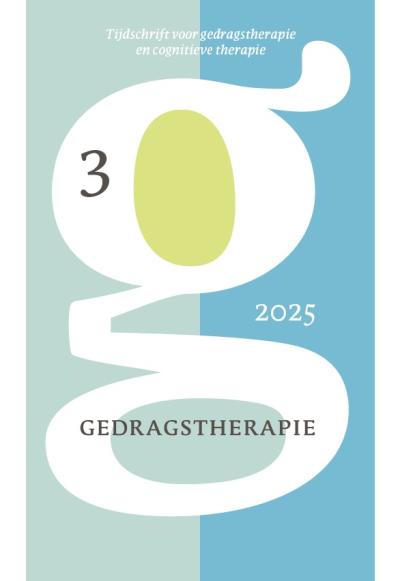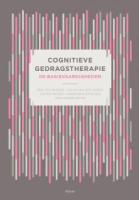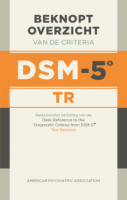Inhoud
Bijna Perfect: Onderzoek naar de validiteit en betrouwbaarheid van de Nederlandstalige Almost Perfect Scale-Revised in een polikli psychiatrische steekproef
Samenvatting
Slaney, Rice, Mobley, Trippi & Ashby (2001) ontwikkelden de Almost Perfect Scale-Revised om de adaptieve en maladaptieve aspecten van perfectionisme te meten. De huidige studie onderzoekt de psychometrische kwaliteiten - factorstructuur, interne consistentie en begripsvaliditeit - van de vragenlijst in een Nederlandse klinische psychiatrische steekproef (n=567).
De exploratieve en confirmatorische factoranalyses repliceerden op adequate wijze de onderliggende dimensies ‘High Standards', ‘Discrepancy' and ‘Order'. De drie APS-R schalen bezitten een goede interne consistentie en vertonen een adequate convergente validiteit. In tegenstelling echter tot eerdere bevindingen in studentensteekproeven worden in de huidige klinische groep hogere correlaties gevonden tussen metingen van adaptieve - het hanteren van hoge normen - en maladaptieve aspecten van perfectionisme. De APS-R is zeker bruikbaar als instrument voor onderzoeksdoeleinden; voor klinische toepassingen is verder onderzoek in volwassen normatieve steekproeven nodig.
Literatuur
- Alden, L.E., Bieling, P.J., & Wallace, S.T. (1994). Perfectionism in an interpersonal context: A self-regulation analysis of dysphoria and social anxiety. Cognitive Therapy and Research, 18, 297–316.
- Ashby, J. & Rice, K.G. (2002). Perfectionism, dysfunctional attitudes and self-esteem: A structural equation analyses. Journal of Counseling and Development, 80, 197-203.
- Ashby, J.S., Rice, K.G., Kutchins, C.B. (2008). Matches and mismatches: Partners, perfectionism, and premarital adjustment. Journal of Counseling Psychology, 55, 125-132.
- Axtell, A., & Newlon, B.J. (1993). An analysis of Adlerian life themes of bulimic women. Individual Psychology: Journal of Adlerian Theory, Research & Practice, 49, 58-67.
- Bardone-Cone, A.M., Wonderlich, S..A., Frost, R.O., Bulik, C.M., Mitchell, J.E., Uppala, S., & Simonich, H. (2007). Perfectionism and eating disorders: Current status and future directions. Clinical Psychology Review, 27, 384-405.
- Bentler, P.M (1990). Comparative fit indexes in structural models. Psychological Bulletin, 107, 238-246.
- Bentler, P.M. (1992). On the fit of models to covariances and methodology to the Bulletin. Psychological Bulletin, 112, 400-404.
- Bieling, P.J., Israeli, A..L., & Antony, M.M. (2004). Is perfectionism good, bad, or both? Examining models of the perfectionism construct. Personality and Individual Differences, 36, 1373-1385.
- Cattell, R.B. (1966). The scree test for the number of factors. Multivariate Behavioral Research, 1, 245-276.
- Clark, M.A., Lelchook, A.M., & Taylor, M.L. (2010). Beyond the Big Five: How narcissism, perfectionism, and dispositional affect relate to workaholism. Personality and Individual Differences. 48, 786-791.
- De Paepe, D. (2010). De Frost Multidimensional Perfectionism Scale: Onderzoek naar de validiteit en betrouwbaarheid van de Nederlandstalige versie. Unpublished Master thesis, Vrije Universiteit Brussel.
- Frost, R.O., Heimberg, R.G., Holt, C.S., Mattia, J.I., & Neubauer, A.L. (1993). A comparison of two measures of perfectionism. Personality and Individual Differences, 14, 119-126.
- Frost, R.O., Marten, P., Lahart, C., & Rosenblate, R. (1990). The dimensions of perfectionism. Cognitive Therapy and Research, 14, 449-468.
- Grzegorek, J. L., Slaney, R.B., Franze, S., & Rice, K.G. (2004). Self-criticism, dependency, self-esteem, and grade point average satisfaction among clusters of perfectionists and nonperfectionists. Journal of Counseling Psychology, 51, 192-200.
- Harvey, B., Pallant J., & Harvey, D. (2004). An Evaluation of the Factor Structure of the Frost Multidimensional Perfectionism Scale. Educational and Psychological Measurement, 64, 1007-1018.
- Hamacheck, D.E. (1978). Psychodynamics of normal and neurotic perfectionism. Psychology, 15, 27-33.
- Hewitt, P.L., & Dyck, D.G. (1986). Perfectionism, stress, and vulnerability to depression. Cognitive Therapy and Research, 10, 137–142.
- Hewitt, P.L., & Flett, G.L. (1991). Dimensions of perfectionism in unipolar depression. Journal of Abnormal Psychology, 100, 98–101.
- Horn, J. L. (1965). A rationale and test for the number of factors in factor analysis. Psychometrika, 30, 179-185.
- Hu, L., & Bentler, P.M. (1999). Cutoff criteria for fit indexes in covariance structure analysis: Conventional criteria versus new alternatives. Structural Equation Modeling, 6, 1-55.
- Hubbard, R., & Allen, S.J. (1987). An empirical comparison of alternative methods for principal component extraction. Journal of Business Research, 15, 173-190.
- Jacobson, N.S., & Traux, P. (1991). Clinical significance: A statistical approach to defining meaningful change in psychotherapy research. Journal of Consulting and Clinical Psychology, 59, 39-49.
- Jöreskog, K.G., & Sörbom, D. (2005). LISREL 8.72 for Windows [Computer software], Scientific Software International, Lincolnwod, IL.
- Kaiser, H.F. (1960). The application of electronic computers to factor analysis. Educational and Psychological Measurement, 20, 141-151.
- Kline, P. (1993). The handbook of psychological testing. London: Routledge.
- Kline, R.B. (1998). Principles and practice of structural equation modeling. NY: Guilford Press.
- MacCallum, R.C., Browne, M.W., & Sugawara, H.M. (1996). Power analysis and determination of sample size in covariance structure modeling. Psychological Methods, 1, 130–149.
- Marsh, H.W., Balla, J.R., & McDonald, R.P. (1988). Goodness of fit indexes in confirmatory factor analysis: The effect of sample size. Psychological Bulletin, 103, 391-410.
- Nakano, K. (2009). Perfectionism, self-efficacy and depression: Preliminary analysis of the Japanese version of the almost perfect scale-revised. Psychological Reports, 104, 896-908.
- Öngen, D.E. (2009). The relationship between perfectionism and aggression among adolescents. Procedia-Social and Behavioral Sciences, 1, 1073-1077.
- Pearson, C A., & Gleaves, D.H. (2006). The multiple dimensions of perfectionism and their relation with eating disorder features. Personality and Individual Differences, 41, 225-235.
- Pliner, P., & Haddock, G. (1996). Perfectionism in weight-concerned and -unconcerned women: An experimental approach. International Journal of Eating Disorder, 19, 381-389.
- Rice, K.G., & Ashby, J.S. (2007). An efficient method for classifying perfectionists. Journal of Counseling Psychology, 54, 72-85.
- Rice, K.G., Ashby, J.S., & Slaney, R.B. (1998). Self-esteem as a mediator between perfectionism and depression: A structural equations analysis. Journal of Counseling Psychology, 45, 304-314.
- Rice, K.G., Ashby, J.S., & Slaney, R.B. (2007). Perfectionism and the five factor model of personality. Assessment, 14, 385-398.
- Rice, K.G., Vergara, D.T., & Aldea, M.V. (2006). Cognitive-affective mediators of perfectionism and college student adjustment. Personality and Individual Differences, 40, 463-473.
- Schotte, C.K.W., & De Doncker (2004). Nederlandstalige versie van de APS-R, met toestemming van de oorspronkelijke auteurs. Edegem, Universitair Ziekenhuis Antwerpen.
- Schotte, C.K.W, De Doncker, D., & Courjaret J. (2007). De ADP-IV: Vragenlijst voor DSM-IV én gedragstherapeutische diagnostiek. Gedragstherapie, 40, 113-125.
- Schotte, C.K.W., De Doncker, D., Dmitruk, D., Van Mulders, I., D'Haenen, H., & Cosyns, P. (2004). The ADP-IV questionnaire: Differential validity and concordance with the semi-structured interview. Journal of Personality Disorders, 18, 405-419.
- Schotte, C.K.W., & De Doncker, D., Van Kerckhoven C., Vertommen, H., & Cosyns, P.(1998). Self-Report Assessment Of The DSM-IV Personality Disorders. Measurement Of Trait And Distress Characteristics: The ADP-IV. Psychological Medicine, 28, 1179-1188
- Schumacker, R.E., &. Lomax, R.G. (2004). A beginner's guide to structural equation modeling, Second edition. Mahwah, NJ: Lawrence Erlbaum Associates.
- Shumaker, E.A., & Rodebaugh, T. L. (2009). Perfectionism and social anxiety: Rethinking the role of high standards. Journal of Behaviour Therapy and Experimental Psychiatry, 40, 423-433.
- Slaney, R.B., & Ashby, J.S. (1996). Perfectionists: Study of a criterion group. Journal of Counseling and Development, 74, 393-398.
- Slaney, R.B., Chadha, N., Mobley, M., & Kennedy, S. (2000). Perfectionism in Asian Indians: Exploring the meaning of the construct in India. The Counseling Psychologist,28, 10-31.
- Slaney, R.B., & Johnson, D.G. (1992). The Almost Perfect Scale. Unpublished manuscript, Pennsylvania State University, State college.
- Slaney, R.B., Rice, K.G., & Ashby, J.S. (2002). A programmatic approach to measuring perfectionism: The almost perfect scales. In G. L. Flett & P. L. Hewitt (Eds.),Perfectionism: Theory, research, and treatment (pp. 63-88). Washington, DC: American Psychological Association.
- Slaney, R.B., Rice, K.G., Mobley, M., Trippi, J., & Ashby, J.S. (2001). The almost perfect scale revised. Measurement and Evaluation in Counseling and Development, 34, 130-145.
- Slaney, R.B., Mobley, M., Trippi, J., Ashby, J.S., & Johnson, D.G. (1996). Almost perfect scale revised. Unpublished manuscript, Pennsylvania State University State College.
- Slaney, R.B., Rice, K.G., & Ashby, J.S. (2002). A programmatic approach to measuring perfectionism: The almost perfect scales. In G. L. Flett & P. L. Hewitt (Eds.), Perfectionism: Theory, research, and treatment (pp. 63-88). Washington, DC: American Psychological Association.
- Sorotzkin, B. (1985). The quest for perfection: Avoiding guilt or avoiding shame? Psychotherapy, 22, 564–571.
- Stöber, J. (1998). The Frost Multidimensional Perfectionism Scale: More perfect with four (instead of six) dimensions. Personality and Individual Differences, 24, 481-491.
- Stoeber, J., & Otto, K. (2006). Positive conceptions of perfectionism: Approaches, evidence, challenges. Personality and Social Psychology Review, 10, 295-319.
- Stumpf, H., & Parker, W.D. (2000). A hierarchical structural analysis of perfectionism and its relation to other personality characteristics. Personality and Individual Differences, 28, 837-852.
- Terry-Short, L.A; Owens, R.G., Slade, P.D; Dewey, M.E. (1995). Positive and negative perfectionism. Personality and Individual Differences, 18, 663-668.
- Wang, K.T., Slaney, R.B., & Rice, K.G. (2007) Perfectionism in Chinese university students from Taiwan: A study of psychological well-being and achievement motivation. Personality and Individual Differences, 24, 1279-1290.
- Wang, K.T., Yuen, M. & Slaney, R.B (2009) Perfectionism, depression, loneliness, and life satisfaction: A study of high school students in Hong Kong. The Counseling Psychologist, 37, 249-274.
- Zhang, Xiu-Ge (2008). Applicability of Chinese Almost Perfect Scale - Revised in junior high school students. Chinese Mental Health Journal, 22, 895-898.
- Zwick, W.R., & Velicer, W.F. (1986). Comparison of five rules for determining the number of components to retain. Psychological Bulletin, 99, 432-442.
 © 2009-2025 Uitgeverij Boom Amsterdam
© 2009-2025 Uitgeverij Boom Amsterdam
De artikelen uit de (online)tijdschriften van Uitgeverij Boom zijn auteursrechtelijk beschermd. U kunt er natuurlijk uit citeren (voorzien van een bronvermelding) maar voor reproductie in welke vorm dan ook moet toestemming aan de uitgever worden gevraagd:
Behoudens de in of krachtens de Auteurswet van 1912 gestelde uitzonderingen mag niets uit deze uitgave worden verveelvoudigd, opgeslagen in een geautomatiseerd gegevensbestand, of openbaar gemaakt, in enige vorm of op enige wijze, hetzij elektronisch, mechanisch door fotokopieën, opnamen of enig andere manier, zonder voorafgaande schriftelijke toestemming van de uitgever.
Voor zover het maken van kopieën uit deze uitgave is toegestaan op grond van artikelen 16h t/m 16m Auteurswet 1912 jo. Besluit van 27 november 2002, Stb 575, dient men de daarvoor wettelijk verschuldigde vergoeding te voldoen aan de Stichting Reprorecht te Hoofddorp (postbus 3060, 2130 KB, www.reprorecht.nl) of contact op te nemen met de uitgever voor het treffen van een rechtstreekse regeling in de zin van art. 16l, vijfde lid, Auteurswet 1912.
Voor het overnemen van gedeelte(n) uit deze uitgave in bloemlezingen, readers en andere compilatiewerken (artikel 16, Auteurswet 1912) kan men zich wenden tot de Stichting PRO (Stichting Publicatie- en Reproductierechten, postbus 3060, 2130 KB Hoofddorp, www.cedar.nl/pro).
No part of this book may be reproduced in any way whatsoever without the written permission of the publisher.
Inloggen VGCt en VVGT
Leden van de VGCt en de VVGT loggen in via de site van hun vereniging. Als u op die site bent ingelogd als lid, vindt u daar een button naar het Tijdschrift voor Gedragstherapie.
English
Behavioral Therapy: Journal for Behavioral Therapy and Cognitive Therapy ISSN 0167-7454
Information in English can be found here.







